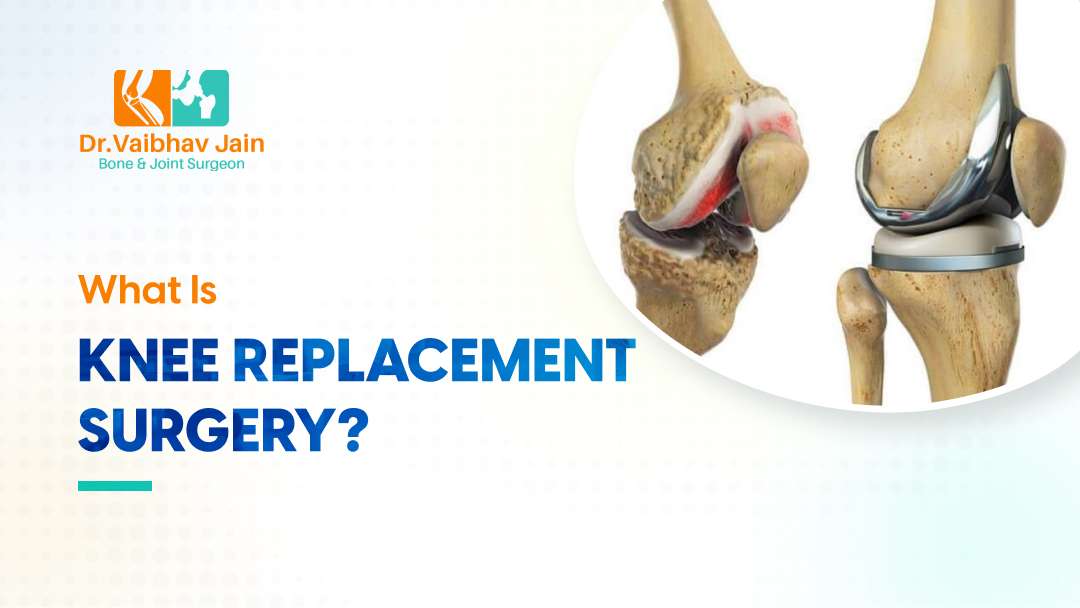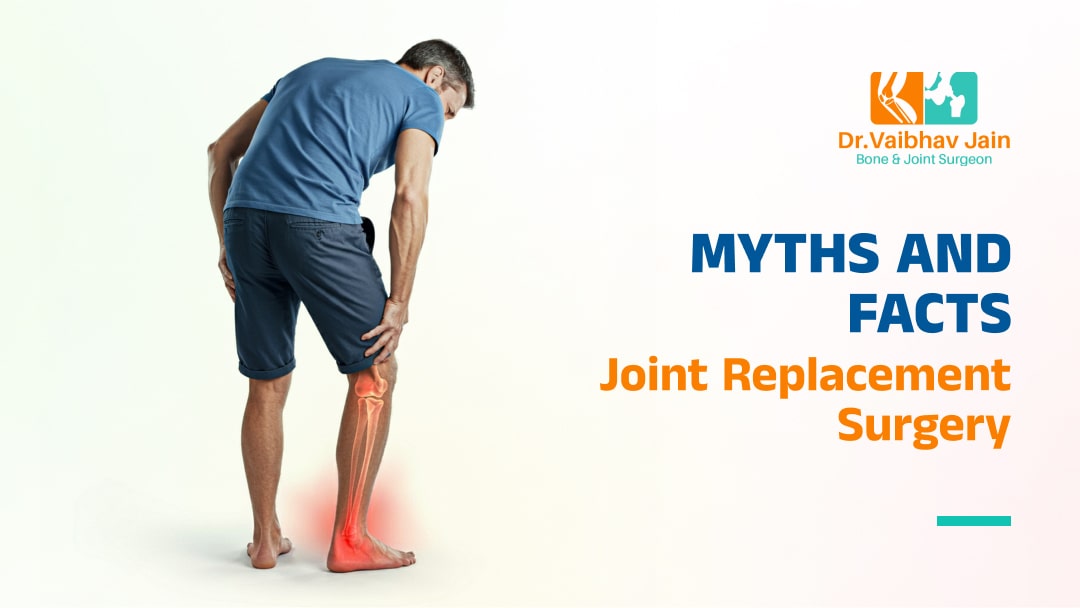Knee replacement surgery in Noida and Delhi, also known as total knee replacement arthroplasty, is a surgical procedure in which surgeons replace the damaged surfaces of the bones that make up the knee joint with artificial material or implant.
In a total knee replacement, the part of the bone that makes up the joint is not actually removed and replaced, but instead, only the damaged part is cut out and prosthetic components or implants are added to cap the ends of the bones. However, the better term to use is ‘knee resurfacing operation’. This procedure is performed to relieve joint pain and disability in patients with Osteoarthritis. It can also improve knee function in cases of arthritis, trauma or injury.
Another form of knee replacement surgery is partial knee replacement. Partial knee replacement surgery is performed rigidly in a partially damaged knee. It is less invasive yet is as good as total knee replacement surgery. Here the knee is opened up and a prosthesis (prosthesis) is placed over the damaged area. Partial knee replacement surgery is preferred in younger patients.
Benefits after knee replacement surgery
| Benefit | What It Does |
|---|---|
| Less Pain | Reduces knee pain so you can move more comfortably. |
| Better Movement | Helps you move your knee more easily. |
| Improved Walking | Makes walking easier and more enjoyable. |
| Stronger Knee | Makes your knee stronger and more stable. |
| Faster Recovery | Shortens the time it takes to get back to normal activities. |
| Better Quality of Life | Makes daily activities like climbing stairs and playing sports more enjoyable. |
Who Can Have Knee Pain?
Generally, knee pain can occur at any stage in women, men, children, and old people. This disease is a little more troublesome in old age. The joints formed between the legs are called knees. The work of the knees is done in many types of work, from getting up and walking to walking. When there is a pain in these joints, then the daily routine of the person changes. There are many reasons behind this pain, which can last for a short time and have the potential to trouble you for life. due to the increasing workload day by day, going to the office in the morning and then sitting at your desk and having breakfast, tea, and lunch, all this is also considered a big reason for knee pain. Keeping the feet in the same position for a long time has a very bad effect on the knees.
Let Us Tell You In Detail About Knee Replacement Surgery
- Why is knee replacement done?
- How to avoid knee replacement?
- Preparing Before Knee Replacement?
- How is knee replacement done?
- What types of implants are used in knee replacement?
- How to take care after knee replacement?
- What changes can one make at home to prepare for recovery after knee replacement?
- Frequently asked questions about Knee Replacement?
1. Why Is Knee Replacement Done?
In arthritis that causes pain and disability, total knee replacement is the most common reason for surgery. In addition, total knee replacement surgery may be required in the following cases:
- Osteoarthritis (a condition causing painful inflammation in the joints)
- Other conditions, such as rheumatoid arthritis
- The knee injury that leads to arthritis
- Fracture, Ligament tear, Cartilage tear resulting in severe damage to the knee
- Severe and chronic knee pain
- Swelling in the knees that cannot be reduced with medicine
- Joint stiffness
- Low-speed limit
- Limp
- Joint deformity
- Joint tenderness
2. How To Avoid Knee Replacement?
Dr Vaibhav Jain will decide after a proper examination whether you are fit for this surgery or not. Patients who are suggested not to have knee replacement surgery are
- Patients have difficulty extending their knees. E.g. when we stand from a sitting position, the knee extends
- Patients with sepsis (infection)
- Patients under 50 years of age (although patients who may still undergo knee replacement if they are in severe pain and have tried and exhausted all other treatment options)
- Very fat people
- A physically demanding profession involves daily high-impact activity, where the results of surgery may not be long-lasting
3. Preparing Before Knee Replacement?
Before knee replacement surgery, Dr Vaibhav Jain may do some tests to diagnose problems with your joints.
- Physical examination – The patient is examined in a lying position. The doctor then looks for signs of joint inflammation, joint deformity, and muscle damage. The doctor then feels the joint to check for warmth, swelling, fluid, and tenderness of the joint. In addition, doctors check the range of motion of the joint by rotating the knee back and forth to check for any stiffness of the joint.
- Blood tests – Special blood tests may be done to check the level of inflammation or the presence of antibodies. For example, the presence of rheumatoid factor (RF) in the blood may indicate the presence of autoimmune disease, particularly rheumatoid arthritis. Common blood tests like CBC, blood glucose, kidney function test, and liver function test are done beforehand.
- Joint aspiration – In this procedure, a small sample of fluid is collected from the knee joint using a needle and sent for further examination. This is done in selected patients only when needed.
- Imaging tests – The most commonly used imaging tests are X-rays as they help to see structural changes, signs of joint wear, loss of cartilage or tissue tearing, swelling, amount of fluid present, etc. Sometimes an MRI or CT scan is planned to obtain further information.
4. How Is Knee Replacement Done?
Knee replacement surgery is performed under spinal or general anaesthesia.
- During knee replacement surgery, a cut is made on the skin at the front of the knee to access the kneecap (patella). The patella is then rotated outwards to get a better view of the area that needs repair.
- The femur, the lower end of the thigh bone, is then measured and brought back to the front. The damaged portion of bone and cartilage is cut from the lower end of the femur using special instruments and then fitted to the metal femoral component of the prosthetic knee.
- After, the tibia (shin bone) is regenerated by removing the damaged bone and cartilage from the upper end of the tibia and then reshaped to fit the plastic or metal tibial component.
- The patella is re-adjusted. The damaged part of the patella is repositioned and fitted with a patellar button, or the patella is reshaped. The surgeon adds a plastic spacer between the femoral and tibial components to avoid friction between the prostheses.
- The prosthesis is usually attached to the bone by surgical cement and is known as a cemented prosthesis.
- The function of the replacement is checked by bending the knee and the incision is closed with sutures or surgical staples.
- Knee replacement surgery in the right way can provide your knee with function for about 10 to 15 years.
5. What Types Of Implants Are Used In Knee Replacement?
- Different types of knee replacements exist, but the standard way of performing the surgery is to fix the parts with bone cement.
- The parts themselves are made of cobalt-chromium alloy or titanium. Oxinium or gold knee replacement is used in selected patients.
6. How To Take Care After Knee Replacement?
After knee replacement surgery, the patient is shifted to the recovery room, where vital organs are monitored under the supervision of a doctor. Also, physical therapy can be started on the same day. The patient may have to stay in the hospital for about 3 to 5 days. After a few days, the patient is allowed to go home.
- The patient initially requires a walker, crutches or a stick.
- Upon reaching home, the patient should continue with an exercise and physical therapy.
- There may be difficulty in getting up or sitting down but the patient is advised to keep moving his/her knees.
- The patient should follow the instructions given by the surgeon and contact his surgeon in case of any complications.
- The doctor is appointed a physiotherapist who will guide the rehabilitation and help in achieving full functioning of the knee.
7. What Changes Can One Make At Home To Prepare For Recovery After Knee Replacement?
- Make room at home for ease of movement.
- Installing a railing in the bathroom and next to the toilet.
- Keep a non-slip bath mat ready.
- Wear socks without slipping.
- Installing night lights.
- Ask for help If close friends and family can’t help, get a nurse or domestic help to help, at least for the first few weeks.
Frequently Asked Questions
Your doctor usually recommends you try different methods to relieve your symptoms before recommending surgery. Some of these non-surgical methods include:
- Physiotherapy
- Weight loss
- Medicines to reduce joint swelling
- Cartilage repair supplements
- Acupressure
However, if these non-surgical techniques do not ease your joint pain and interfere with your day-to-day activities, thereby hindering your quality of life, Knee replacement surgery may be the best option for you.
Most knee replacement surgeries take 1 to 1.5 hours.
- Normal pain may persist for several weeks after surgery.
- Swelling may persist for 2 to 3 weeks to 3 to 6 months.
- Bruising can occur for a few weeks after surgery.
Most people need the help of crutches or walker or stick during the first few months after surgery. The physiotherapist will teach you how to walk using your new knee and give you exercises to improve the mobility of your joint. Sometimes your orthopaedic surgeon may suggest you use a CPM machine. CPM machines help you maximize your range of motion and minimize scar formation. However, once you have fully recovered, you do not need to use any support to carry out your day-to-day activities.
Usually the patient can be discharged from the hospital within 1 to 5 days and they can resume their daily activities within 6 weeks after the surgery. However, it may take 3 to 6 months for a full recovery after surgery.
Knee replacement surgery is a medical procedure that involves the removal of damaged or diseased parts of the knee joint and their replacement with artificial parts, known as prostheses. This surgical procedure is usually recommended for people who suffer from chronic knee pain, stiffness, or decreased mobility due to conditions such as arthritis or injury.
There are two main types of knee replacement surgery: partial knee replacement (also called unicompartmental knee replacement), and total knee replacement. Partial knee replacement involves replacing only the damaged portion of the knee joint, while total knee replacement involves replacing the entire knee joint.





